Hockey cards don’t have quite as long a pedigree as their baseball equivalents, but it’s close. The first appeared, somewhat predictably, in Canada back in 1910. Like the earliest baseball cards, they were to be found in tobacco products. Before the Second World War, O-Pee-Chee became the leading manufacturer, but they went on hiatus during the war. The manufacturing resources were needed for dumb stuff like guns and shells.
But hockey cards came back with a vengeance in the 1950s. A new company, Parkhurst, entered the market in 1951 and included hockey cards with their confectionary products. Their iconic releases were known in Canada as “Parkies” and went for five cents. Each came complete with a stick of gum and four or five cards. These classic sets created the modern hockey card, just as Topps was doing the same for baseball south of the border.
However, due to licensing issues, in 1955 and 1956, Parkhurst featured only the two Canadian teams of the time, the Montreal Canadiens and the Toronto Maple Leafs. At this point, Topps entered the fray and revived the O-Pee-Chee brand for Canada, starting with their 1957-58 NHL set. Topps produced an almost identical set for the US market. The two companies competed for dominance until Parkhurst went under in 1964. The competition was fierce, and a memorable golden age of hockey cards ensued as a byproduct. These are the best and most valuable cards of that era.
1953 Parkhurst Gump Worsley Rookie Card #53

A PSA 8.5 sold for $4,579.
Before we talk about anything else, let’s appreciate how great a name Gump Worsley is. Unbeatable. He was also a wonderful goalie, winning two Vezina Trophies at a time when there was some fierce competition. as the league’s best goaltender in both 1965-66 and 1967-68. Gump was also a pioneer, leading the first attempt to unionize hockey players. That sounds like something Forrest Gump would do. Just saying.
The 1953 Parkhurst Gump Worsley Rookie Card #53 makes our friend look like he is in the midst of an interpretive dance session, wearing a particularly creative costume. There aren’t many graded copies of this card, only 313. Amongst them, only 35 are over a PSA 7. So, I can imagine the value going up quite a bit.
1951 Parkhurst Terry Sawchuk Rookie Card #61
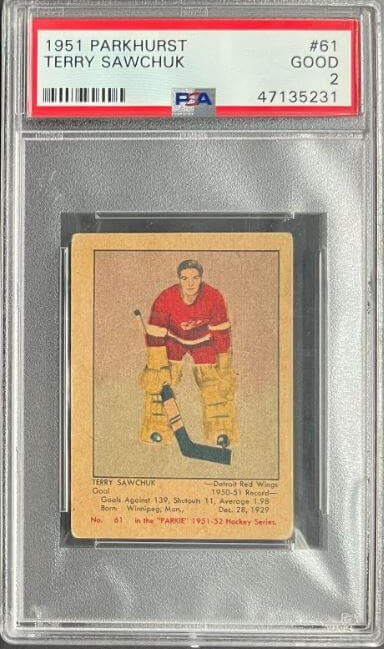
A PSA 9 sold for $7,800.
As one of the greatest goalkeepers ever, you would expect Terry Sawchuk’s rookie card to command a higher price than it does. But to some extent, the 1951 Parkhurst Terry Sawchuk Rookie Card #61 is a victim of the series it appears in. The set is best known for the Gordie Howe rookie card and the Maurice Richard. So, Sawchuck sometimes gets overlooked. But that is unfair. Terry was so good that he won the Vezina Trophy four times and the Stanley Cup four times. And he didn’t even have to wait to get elected to the Hall of Fame. They instated him almost immediately, waving the three-year cooling-off period. And he is still considered a top 5 goalie.
What about the card? Because Terry Sawchuck is a goalie, there is more detail on his equipment than on the Howe card. And that adds depth to it. The picture has added artistry because Sawchuck looks so small and young. It almost tears my eyes like he is standing alone against the world but ready to face all challengers.
1952 Parkhurst Tim Horton Rookie Card #58

A PSA 8 sold for $8,100.
Tim Horton wasn’t just a legendary hockey player; he also created the coffee and doughnut franchise, which has become a cornerstone of Canadian identity. He was the original iron man of the sport, playing 468 consecutive regular-season games from 1961-68. An incredible achievement when you consider how violent the game was at the time. Horton’s legend is carried by the coffee chain and boosted due to his tragic death in a car crash at 44.
The legacy of Tim makes the 1952 Parkhurst Tim Horton Rookie Card #58 the most important card in the release. Like all cards in that release, the simple, almost plaintive hand painting and the faux signature yield a beautiful result. And the position really captures Horton’s rugged playing style. Honestly, the image has a bit of an Edward Hopper vibe. That’s how evocative the artwork is.
1957 Parkhurst Frank Mahovlich #17
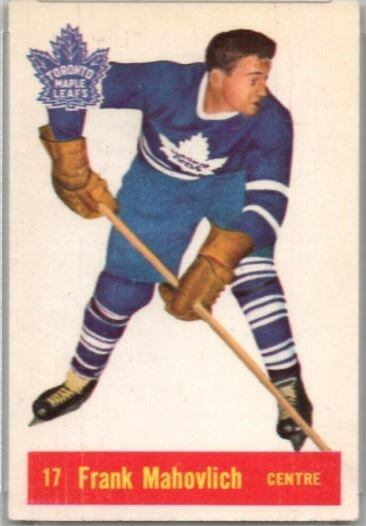
A PSA 9 sold for $8,600.
This son of Croatian immigrants was among the great winners in the game’s history, winning Stanley Cups in 1962, 1963, 1964, 1967, 1971, and 1973. His peak was in that stretch of three championships in a row for the Toronto Maple Leafs when three straight Stanley Cup championships with Leafs from 1962-64 when Frank Mahovlich led the team in scoring every season. But perhaps his greatest contribution to the sport is that Frank is believed to be the first player in history to lift the Stanley Cup over his head. Lord knows he had enough opportunities to be creative with the trophy.
The 1957 Parkhurst Frank Mahovlich #17 card has that simple, plaintive artwork that Parkhurst is famous for. But you can see the influence from Topps as the logo appears in the top-left corner, and the name is emblazoned American style on the bottom of the card. There are only some graded copies of this card. But a good 10 of them are PSA 9s, reflecting the improved centering and quality control of Parkhurst cards towards the end of the decade.
1957 Topps Glenn Hall #20
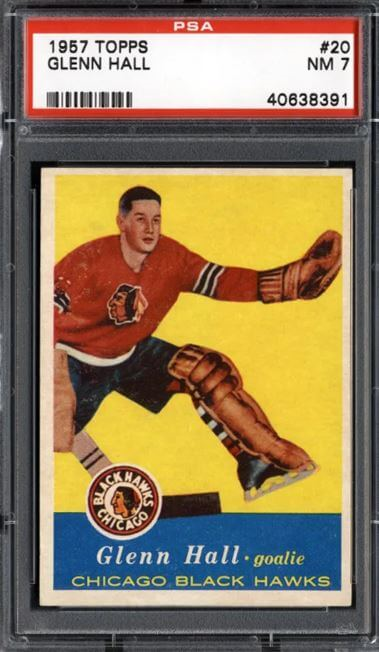
A PSA 9 sold for $9,900.
Hall was one the greatest goaltender of his era. You don’t earn the nickname “Mr. Goalie” by being mediocre. And he rarely missed a game, playing in every single one of his teams’ contests in eight different seasons while winning the Vezina Trophy for best goalie three times. Glenn Hall is perhaps best remembered as the originator of the “butterfly” technique, wherein the goalie drops to his knees to protect the lower half of the net.
The 1957 Topps Glenn Hall #20 artwork is familiar to baseball card collectors, as it is very much in the vein of the 1956 Topps Baseball cards, though with less attention to detail. The illustrations are more fleshed out than their Parkhurst equivalents, and the Hall image is beautiful.
1953 Parkhurst Jean Beliveau Rookie Card #27
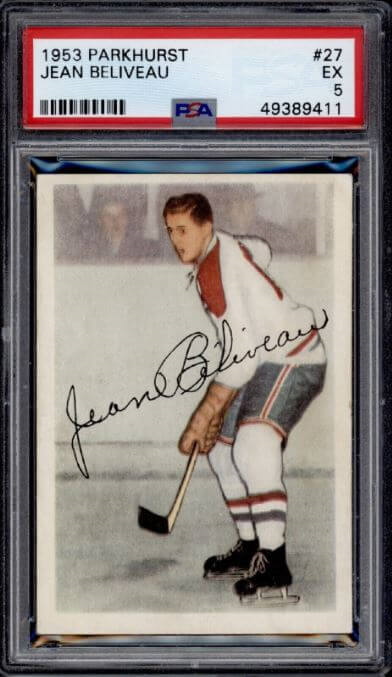
A PSA 9 sold for $16,730.
The 1950s had its share of the greatest hockey players, and Jean Beliveau was close to the top of that list. "Le Gros Bill" was the greatest winner in the game’s history. He won 10 Stanley Cup titles as a player. That means he won the championship in half of the seasons he played. Then as an executive, Beliveau helped the Montreal Canadiens to 7 more titles. 17 Stanley Cups is a decent enough haul.
The 1953 Parkhurst Jean Beliveau Rookie Card #27 is one of the most beautiful hockey cards of the decade. The beautiful, vivid watercolors and elegant faux signature are incredibly classy. The one weakness is the face, which could have used detailed fleshing. Only 538 graded copies of this beauty exist, and a single PSA 9 lurks in some lucky persons’ collections.
1955 Parkhurst Jacques Plante #50
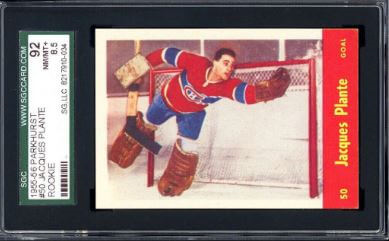
A PSA 8 sold for $24,600.
There are so many incredible legends in these 1950s Parkhurst sets. But few have had as much of a long-term influence as Jacques Plante. He is generally credited as being the first to wear a mask, call plays, and play the puck outside his crease to support his defenseman.
The 1955 Parkhurst Jacques Plante #50 is the key rookie card in the set. Because of its captivating horizontal graphic, it is the most memorable of the top goaltender rookie cards of the decade. But unfortunately, the red-bottom border often chips, and the centering is also an issue. So, finding a copy in good condition is challenging.
1951 Parkhurst #4 Maurice Richard Rookie Card
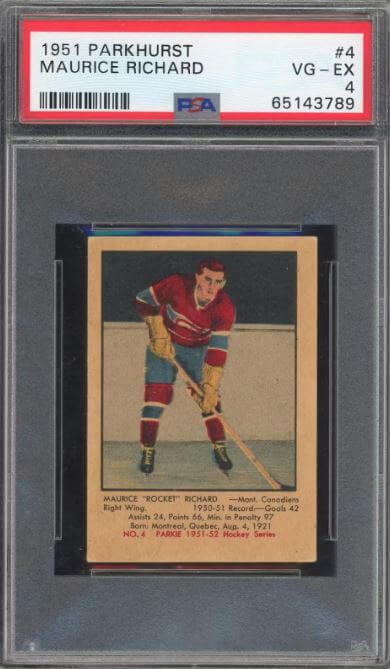
A PSA 9 sold for $57,600.
The 1951 Parkhurst #4 Maurice Richard Rookie Card is the second most important card in this seminal set, behind the Gordie Howe rookie card. Richard was the first player to reach 500 career goals and hit 50 in a season. So, it’s fair to say that hockey had never seen a scorer like Maurice before.
Because Maurice Richard debuted in 1944, this rookie card finds the player late in his career. But that only adds to the mystique of the 1951 Parkhurst release. The card shares the wonderful old-timey aesthetic of that release. But it had a major drawback. That earliest modern hockey product had serious quality control issues, making finding copies of these cards in decent condition almost impossible. However, there are 5 PSA 9s on this card, which I find surprising and even somewhat suspicious.
1958 Topps Bobby Hull Rookie Card #66
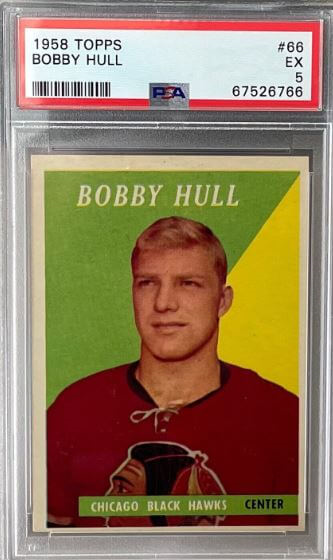
A PSA 8 sold for $102,000.
Though he hasn’t played a game in 40 years and tragically died in 2023, Bobby Hull is still considered one of the top ten NHL players. Ever. Because of his incredible skating speed and shiny blonde hair, Hull was known affectionately as "The Golden Jet.” Bobby led the NHL in goals no less than seven times and the World Hockey Association once, winning 2 Hart Memorial Trophies and 3 Art Ross Trophies over the years. Unfortunately, he has also been linked to domestic violence and praising Hitler. We are here to discuss cards, not politics or morality. And in his favor, he advocated successfully for making hockey less violent. So, imagine how bad it used to be!
The 1958 Topps Bobby Hull Rookie Card #66 looks slightly funny. The colors look like a flavorless old-school ice cream combo, and Hull’s visage is not cleanly cut. But this is the only recognized rookie card of the “Golden Jet,” so its value is assured. No copies graded over a PSA 8 have been sold (though there are 2 PSA 9s), and only 7 of PSA 8s are extant. One reason for that is, of course, that this card is over a half-century old. But this set (particularly the Hull card) has a serious centering problem. Reportedly the problem is that Bobby’s card was the last in the group and at the bottom corner of the uncut sheet, leading to a problem. Therefore, at best, most of these items have a 70/30 centering scheme.
1951 Parkhurst Gordie Howe Rookie Card #66
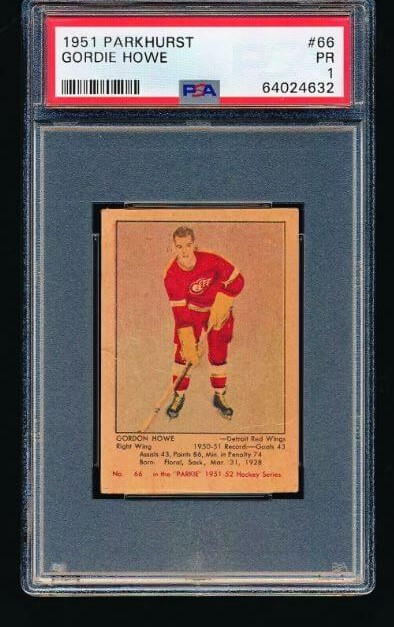
A PSA 8.5 sold for $210,330.
“Mr. Hockey” wasn’t exactly a rookie in 1951. Gordie debuted for the Detroit Red Wings in 1946, but the 1951 Parkhurst Gordie Howe Rookie Card #66 is still his only recognized rookie. After all, hockey cards had come to a standstill during the war and did not get back into the swing of things until 1951. This set was the first major set that relaunched this part of the hobby. And it is a beautiful set. Though it appeared in the 1950s, it still has that early-century cigarette card feel. Of course, I mean that in the best possible way. There is a beautiful innocence to this card. However, it was manufactured in a somewhat primitive way, going through a cement mixer. Therefore, many of these cards came with dings; you can imagine what most look like nowadays.
Gordie Howe was regarded as the best hockey player until Wayne Gretzky knocked him off that perch. But some still consider him as #1, like a recent Bleacher Report list. It’s easy to see why, as he won six MVPs and scoring titles on his way to four Stanley Cup championships. The player was also renowned for scoring the Gordie Howe Hat Trick in most games, which requires" which requires scoring a goal, passing for an assist, and being involved in a fight.
The Final Word Of The Most Valuable Hockey Cards from the 1950s
The release of the 1951 Parkhurst set launched a remarkable era in the history of hockey cards. Many of the Parkhurst cards of the decade were masterpieces, and they were joined by some solid offerings from Topps/O-Pee-Chee late in the decade. The plaintive and moody art in the Parkhurst cards is genuinely Canadian and still resonates all these years later. And you can’t argue with the level of talent that decade produced.
One thing to notice is that population counts are quite low, often below 500. That bodes well for future value. So, there is little danger that these cards will not age well. Just make sure to slab them up and protect these precious works of art.